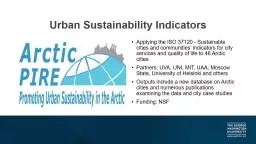

Sustainable cities and communities indicators for city services and quality of life to 46 Arctic cities Partners UVA UNI MIT UAA Moscow State University of Helsinki and others Outputs include a new database on Arctic cities and numerous publications examining the data and city case studie ID: 929968
Download Presentation The PPT/PDF document "Applying the ISO 37120 -" is the property of its rightful owner. Permission is granted to download and print the materials on this web site for personal, non-commercial use only, and to display it on your personal computer provided you do not modify the materials and that you retain all copyright notices contained in the materials. By downloading content from our website, you accept the terms of this agreement.
Slide1
Applying the ISO 37120 - Sustainable cities and communities’ indicators for city services and quality of life to 46 Arctic citiesPartners: UVA, UNI, MIT, UAA, Moscow State, University of Helsinki and othersOutputs include a new database on Arctic cities and numerous publications examining the data and city case studiesFunding: NSF
Urban Sustainability Indicators
Slide2The distribution of CALM sites.CALM observations in Arctic Alaska
Circumpolar Active-Layer Monitoring (CALM): Long-term Observations on the Climate Active-Layer Permafrost System
Depth of annual thaw in permafrost-affected environments (
active-layer thickness
) is one of the main indicators of permafrost stability. This parameter is considered to be the essential climatic variable by the Global Climate Observing System (GCOS).
CALM is the only coordinated program providing collection, standardization, and dissemination of active-layer observations world-wide.
Key partners:
Northern Michigan University
Michigan State University
University of Montana
In collaboration with research and educational institutions from 14 countries. Funding: NSF
Slide3Wildland FiresACRoBEAR examines the connection between fires and human health in the Arctic (Belmont Forum)FIREWALL studies links between Arctic fires and the region’s energy network (NSF)
This project examines the impact of cruise ship tourism on the natural, social and built environments of Arctic cities in North America and Europe. Partners include UAS and University of Colorado in Boulder. NSF
Cruise Ship Tourism
COVID-19 in Juneau
RAPID grant examining governance, economic, Indigenous, healthcare impacts; Key partners – UAS and UAF. NSF